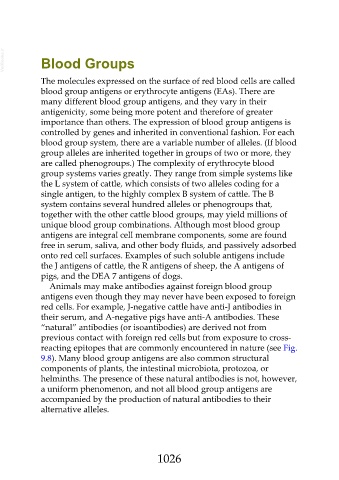Page 1026 - Veterinary Immunology, 10th Edition
P. 1026
VetBooks.ir Blood Groups
The molecules expressed on the surface of red blood cells are called
blood group antigens or erythrocyte antigens (EAs). There are
many different blood group antigens, and they vary in their
antigenicity, some being more potent and therefore of greater
importance than others. The expression of blood group antigens is
controlled by genes and inherited in conventional fashion. For each
blood group system, there are a variable number of alleles. (If blood
group alleles are inherited together in groups of two or more, they
are called phenogroups.) The complexity of erythrocyte blood
group systems varies greatly. They range from simple systems like
the L system of cattle, which consists of two alleles coding for a
single antigen, to the highly complex B system of cattle. The B
system contains several hundred alleles or phenogroups that,
together with the other cattle blood groups, may yield millions of
unique blood group combinations. Although most blood group
antigens are integral cell membrane components, some are found
free in serum, saliva, and other body fluids, and passively adsorbed
onto red cell surfaces. Examples of such soluble antigens include
the J antigens of cattle, the R antigens of sheep, the A antigens of
pigs, and the DEA 7 antigens of dogs.
Animals may make antibodies against foreign blood group
antigens even though they may never have been exposed to foreign
red cells. For example, J-negative cattle have anti-J antibodies in
their serum, and A-negative pigs have anti-A antibodies. These
“natural” antibodies (or isoantibodies) are derived not from
previous contact with foreign red cells but from exposure to cross-
reacting epitopes that are commonly encountered in nature (see Fig.
9.8). Many blood group antigens are also common structural
components of plants, the intestinal microbiota, protozoa, or
helminths. The presence of these natural antibodies is not, however,
a uniform phenomenon, and not all blood group antigens are
accompanied by the production of natural antibodies to their
alternative alleles.
1026

